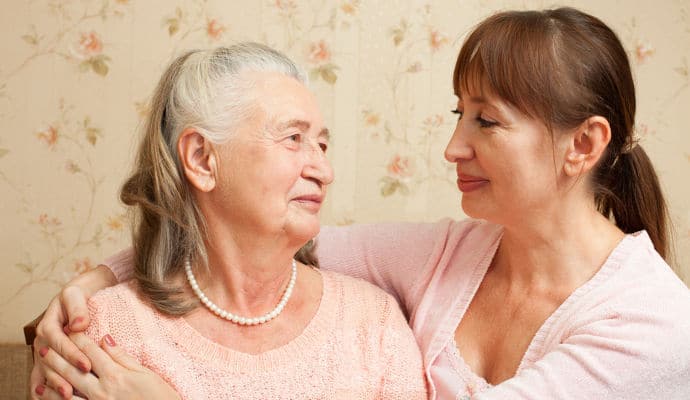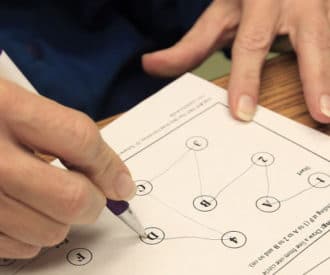Creating a dementia-friendly home isn’t just about safety; it’s about empowering your loved one to navigate daily life with greater ease and dignity. Since dementia can affect vision, depth perception, and spatial awareness, even small changes in their living space can make a significant difference.
From improving lighting to reducing visual clutter, these adjustments help minimize confusion and frustration while promoting independence.
In this article, we’ll share four key ways to make things easier to see, plus a few bonus tips to enhance comfort and accessibility. Whether your loved one is in the early or later stages of dementia, these practical strategies can create a calmer, more supportive home environment.

Small Changes Make Life Easier for Seniors with Dementia
Every day tasks are often challenging for people with Alzheimer’s disease or dementia.
But small changes at home can have a significant impact on making their life easier.
As the disease progresses, your older adult will experience increasing difficulty with memory, thinking, processing, and reasoning.
The top priority is to keep them safe and help them achieve as much independence as possible.
We’ve four ways to create a more dementia-friendly home by making it easier to see and recognize commonly used items.
These suggestions make everyday tasks easier, boosting confidence and reducing frustration and stress.
4 Ways to Create a Dementia Friendly Home by Making Things Easier to See
1. Avoid reflective surfaces and keep the lighting even
Shiny or reflective surfaces on floors or tabletops can be confusing because they create glare and shadows.
For floors, stick to bare hardwood or plain carpeting. If floor coverings are needed, use light colored, non-patterned coverings that are well-secured and non-slip.
For shiny tabletops or counters, cover with light-colored mats or tablecloths. Dark colors may seem like holes, so avoid using those colors on areas where you want your older adult to use them.
Try to make lighting as easy as possible by reducing glare and shadows. Add sheer curtains to mute bright sunlight and use brighter lighting for darker spaces.
2. Add pictures to identify things that aren’t in full view
When someone experiences memory problems, it can be challenging to recall where things are located.
That could mean they need to open every cabinet to find a mug, open all the drawers to find a sweater, or not know where the toilet is.
To help someone with dementia locate frequently used items, it's helpful to add large, easy-to-see pictures on the outside of doors, cabinets, or drawers to identify their contents.
For example, place a picture of a toilet on the bathroom door, ensuring it stands out against the door’s color. On a kitchen cabinet, put a picture of the mug they always use.
Be sure to prioritize which items to label because too many pictures could add to their confusion.
3. Use contrasting colors to highlight important things
Careful use of contrasting colors also helps seniors with dementia see objects more clearly.
For example, when an older adult can see what they’re eating, they’re better able to eat independently.
Using a red plate makes it easier to eat because the plate stands out from a light-colored table or mat, and many foods stand out against the red plate.
Another necessity is using the toilet. This can be challenging because most bathrooms have light colored floors, walls, and toilets.
That can make it tough for someone with dementia to find the actual toilet and could cause them to accidentally go somewhere else, such as a wastebasket or the bathtub.
Changing the toilet seat to a colored one (like a red one) makes it easier to see where to sit quickly.
Alternatively, if your older adult has trouble finding essential rooms like their bedroom or bathroom, you could paint the door a bright, contrasting color.
You could also personalize their bedroom door with a large photo of themselves. In a care community, that could also keep them from accidentally wandering into other people’s rooms when looking for their own.
And to make it easier to turn on room lights, you may want to change the light switch plates to make it stand out clearly from the wall. For example, if the walls are white, consider using a colored switch plate, such as one of these.
4. Make large panes of glass more visible
It can be more difficult for people with dementia to see large panes of glass. That can lead to accidents and injuries.
To make glass more visible, consider adding non-adhesive decals, pictures, or posters to shower doors, patio doors, or picture windows.
This can also be a fun way to add a personal touch to your decor!
A dementia-friendly home isn’t just physical adjustments—it’s about creating a space that supports remaining abilities. Enhancing visibility reduces frustration and helps maintain connection to the environment. – Dr. Al Power (Geriatrician & Author of Dementia Beyond Disease)
Recommended for you:
- How to Understand and Manage Dementia Behaviors: A Comprehensive Guide
- 10 Ways to Respond to Dementia Hallucinations in Seniors
- 7 Ways to Reduce Dementia Sundowning Symptoms
This article contains some affiliate links. If you buy through an affiliate link on our site, we may earn a small commission, at no additional cost to you. For more information, see How We Make Money.
About the Author

Connie Chow
Connie was a hands-on caregiver for her grandmother for 20 years. (Grandma made it to 101 years old!) She knows how challenging, overwhelming, and all-consuming caring for an older adult can be. She also knows how important support is — especially in the form of practical solutions, valuable resources, and self-care tips.





While I am not a proponent of using TV as a sitter for any patient with dementia, I’ve discovered that youtube baby videos are like a daily visit from grandchildren for my 96-year-old mom. She laughs and talks with us about the antics of them, one after another. Especially great when sun-downing.
That’s a wonderful idea! Thanks for sharing
When an alzheimers person is blind……do you have any advice or suggestions?
If someone is blind, they’ll need help to move around and with everyday activities. It might be more helpful to focus on creating a calm, comfortable environment.
To help them find enjoyment and feel useful, we’ve got some activity suggestions for someone who has impaired vision and dementia at 9 Entertaining Activities for Low Vision Seniors with Alzheimer’s or Dementia https://dailycaring.com/9-activities-for-low-vision-seniors-with-alzheimers-or-dementia/